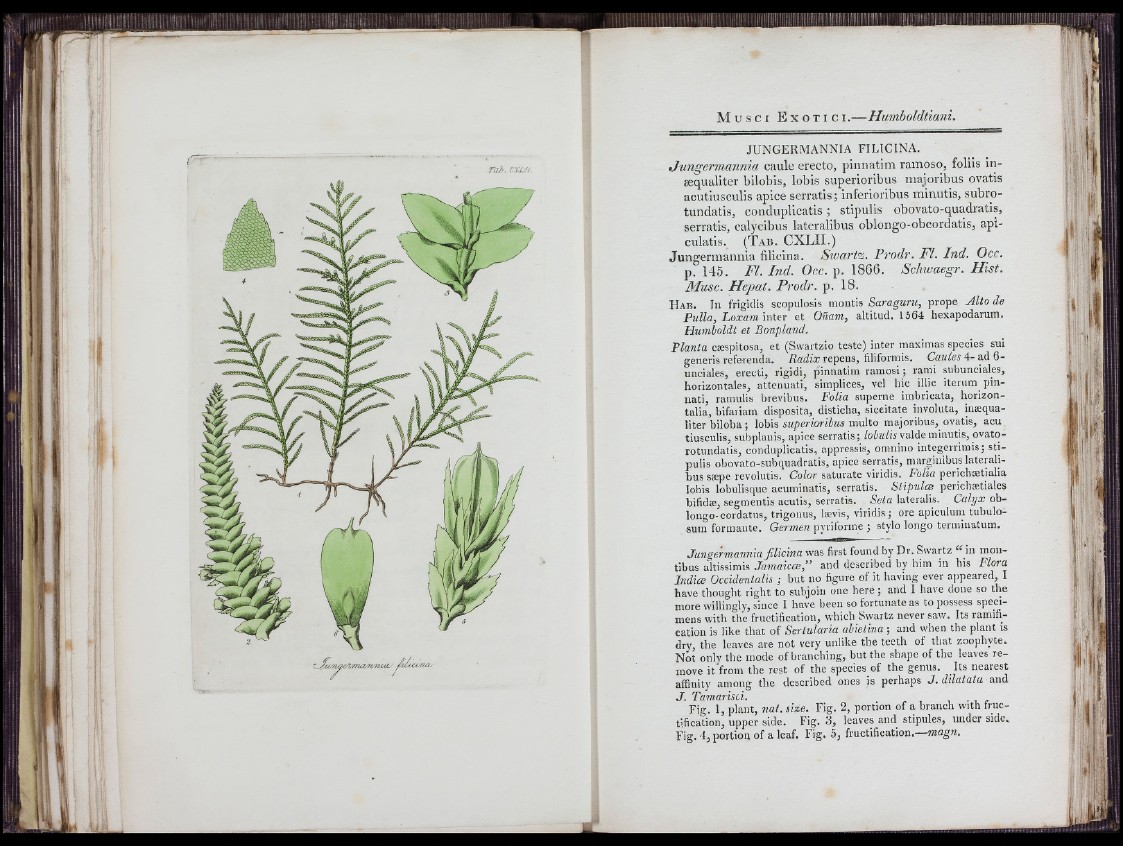
I
(I ' ti i
rot^. cxLfs.
JUNGERMANNIA FILICINA.
Jungermannia caule erecto, pinnatim ramoso, foliis inæqualiter
bilobis, lobis superioribus majoribus ovatis
acutiusculis apice serratis; inferioribus minutis, subro-
tundatis, conduplicatis ; stipulis obovato-quadi’atis,
serratis, calycibus lateralibus oblongo-obcordatis, api-
culatis. (Tab. CXLII.)
Ju n g e rm a n n ia filicina. Siuartz. Prodr. FI. Ind. Occ.
p. 145. FI. Ind. Occ. p. 1866. Schwaegr. Hist.
Musc. Hepat. Prodr. p. 18.
H a b . In frigidis scopulosis montis Saraguru, prope Alto de
Pulla, Loxam \nter et Oñam, altitud. 1564 hexapodarum.
Humloldt et Bonpland.
Pianta cæspitosa, et (Swartzio teste) inter maximas species sui
generis referenda. Radix repens, filiformis. Caules 4- ad 6-
unciales, erecti, rigidi, pinnatim ramosi ; rarni subunciales,
horizontales, attenuati, simplices, vel hic illic iterum pm-
nati, ramulis brevibus. Folia superne imbricata, horizontalia,
bifaiiam disposita, disticha, siccitate involuta, inæqualiter
biloba ; lobis superiorilus multo majoribus, ovatis, acu
tiusculis, subplanis, apice serratis; valde minutis, ovatorotundatis,
conduplicatis, appressis, omnino integerrimis; stipulis
obovato-subquadratis, apice serratis, marginibus lateralj-
bus sæpe revolutis. Color saturate viridis. to lia perichætialia
lobis lobulisque acuminatis, serratis. S tipulæ perichætiales
bifidæ, segmentis acutis, serratis. Seta lateralis. Calyx oblongo
cordatas, trigonus, lævis, viridis; ore apiculum tubulo-
sum formante. Germen pyriforme ; stylo longo terminatum.
Jungermannia filicina was first found by Dr. Swartz “ in montibus
aitissimis Jamaicæ,” and described by him in his Flora
Indiæ Occidenialis ; but no figure of it having ever appeared, I
have thought right to subjoin one here ; and I have done so the
more willingly, since I have been so fortunate as to possess specimens
with the fructification, which Swartz never saw. Its ramification
is like that of Sertularia alietina ; and when the plant is
dry, the leaves are not very unlike the teeth of that zoophyte.
Not only the mode of branching, but the shape of the leaves remove
it from the rest of the species of the genus. Its nearest
affinity among the described ones is perhaps J . dilatata w ú
J . Tamarisci.
Fig. 1, plant, nat. size. Fig. 2, portion of a branch with fructification,
upper side. Fig. 3, leaves and stipules, under side.
Fig. 4, portion of a leaf. Fig. 5, fructification.—magn.